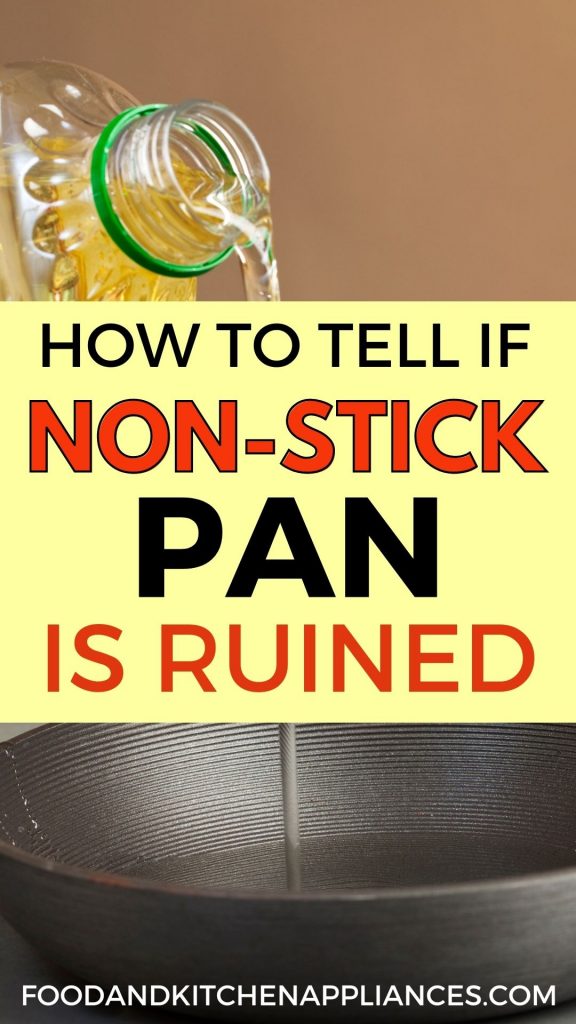When it comes to non-stick pans, you want to ensure that you take care of them properly. If you don’t, then the pan can become damaged and ruined. Therefore, you have to be looking for any damage to a non-stick pan. Here is how to tell if the non-stick pan is ruined. A damaged non-stick pan can be a considerable inconvenience and a health hazard.

Not only will your food not cook evenly, but you’ll also have to scrub the pan extra hard to get the burnt-on food off. So how do you know if your non-stick pan is ruined? There are a few telltale signs that indicate damage. In this blog post, we’ll discuss four of them!
How to Tell If the Non-Stick Pan is Ruined?
If your non-stick pan starts to peel, flake, or chip, it’s likely that the coating is damaged, and you should throw the pan. Another sign that your non-stick pan is no longer suitable for use is if it starts to produce an odor.
For example, suppose you smell something burning when cooking with your non-stick pan; it is time to throw the pan.
The pan is warped
If the pan is warped, it’s not going to lay flat on the burner, which means that your food will not cook evenly. So if you see any warping, it’s time to get a new pan.
Discoloration
If your pan starts to discolor, it’s a sign that the coating is wearing off. It causes the pan to release harmful chemicals when it’s heated. If you see any discoloration on your pan, replace it immediately.
Peeling of Flaking of coating
Non-stick pans are a kitchen essential, but they don’t last forever. If you’re wondering how to tell if the non-stick pan is ruined, look for peeling, flaking, or chipping of the coating.
Scratches in Nonstick pan
If you see any scratches in the non-stick pan, it’s time to replace your cookware. A scratched non-stick pan will cause food to stick and make cleanup more difficult. In addition, if the bottom of your non-stick pan is scratched, it means that the coating has been damaged.
If your non-stick pan starts to peel or flake, it might be time for a new one. The rule of thumb is to get a recent non-stick every five years. However, I noticed that even the long-lasting, better-quality pans last for 4-5 years.
Taking care of Non-stick pans is very important. Otherwise, they will wear off quickly.
The handle is loose
A loose handle is more than just an annoyance; it can be downright dangerous. If the handle on your non-stick pan is loose, stop using the pan immediately and replace it. This one is not associated with non-stick only; you can relate it with any cookware.
Why do non-stick pans not last longer?
The main reason why non-sticks don’t last long is because of the way they are used. When using a metal spatula on a non-stick pan, you’re essentially scratching off the coating. Over time, these scratches will build up, and non-tick properties will deteriorate.
Another reason non-sticks don’t last long is the way they are cleaned. Never wash non-stick pans in the dishwasher because harsh detergents will damage the coating. Instead, non-stick pans should be hand-washed with mild soap and water.
If you follow these tips, you can extend the life of your non-stick pan and get the most out of your cookware.
Another reason for the shorter shelf life of Non-stick pans
A polymer called polytetrafluoroethylene (PTFE) is the ingredient in Non-stick coatings.
PTFE is a synthetic material with a very high melting point, which is why it’s used in non-stick coatings.
PTFE is also known by the brand name Teflon.
While PTFE is very durable, the constant heating and cooling from use and washing can cause the material to break down over time.
When PTFE breaks down, it can release harmful chemicals into the food you’re cooking. For this reason, it’s essential to replace your non-stick pan when the coating starts to wear off.
Is it safe to use scratched non-stick pans?
If the bottom of your non-stick pan is scratched, it means that the coating has been damaged. This can cause your food to stick to the pan and make it more difficult to clean. If you see any scratches on the bottom of your pan, it’s time to get a new one.
Moreover, the chemicals can seep into food and eventually your body. So loading your bodies with more toxins is not a great idea. Instead, the best idea is to cook in metal, ceramic, or stainless steel containers.
While learning all these things, sometimes I think of using earthen pots. So someday, I will start doing this.
For the moment, I am sticking to Iron and stainless steel pans. However, I do have some Non- stick pans that I still use. But once they wear off, I will buy other metal or ceramic containers.
Final thoughts
If your non-stick pan starts to peel, flake, or chip, it’s likely that the coating has been damaged, and time to replace the pan. Another sign that your non-stick pan is no longer suitable for use is if it starts to produce an odor.
If you smell something burning when cooking with your non-stick pan, it may be time to retire it and purchase a new one. Finally, if the bottom of your pans starts to blacken, it’s another indication that the non-stick surface has been compromised and should not be used any longer.
